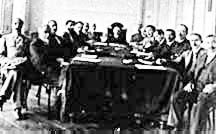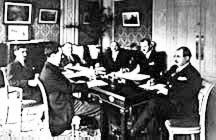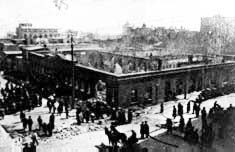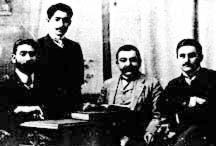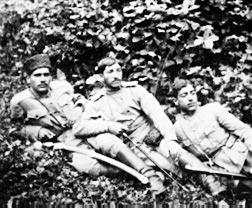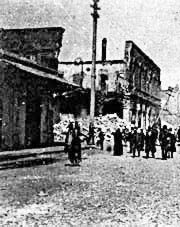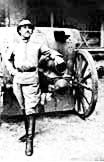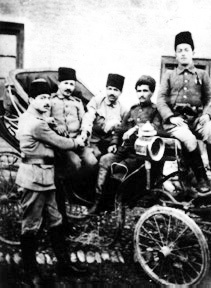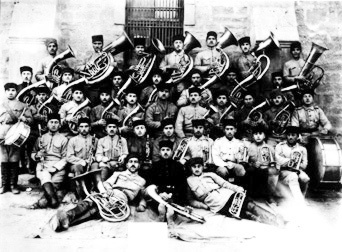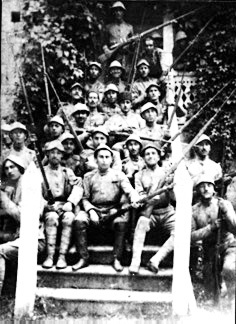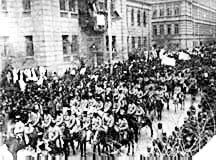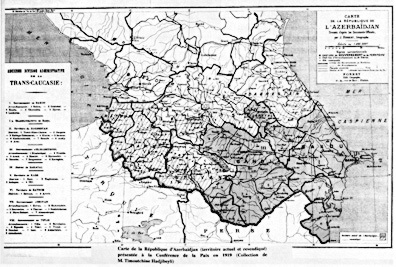|
Spring 1998 (6.1) Democratic Republic
of Azerbaijan by Fuad Akhundov
Above, Left: Fourth Cabinet of Ministers of the Democratic Republic of Azerbaijan (March 14, 1919 - December 22, 1919). Right: Azerbaijan's delegation to the Versailles Peace Conference (1919). The first independent Republic of Azerbaijan existed for 23 months, between May 28, 1918, and April 28, 1920. Without a doubt, the republic existed during the most turbulent, unstable and complicated period of local history in the 20th century. Ethnic conflicts and continuous wars with Armenia, aggravated by the collapse of the Russian Empire, communist coups, civil war in Russia and the consequences of WW I, brought the region of the Caucasus into complete turmoil. This, in turn, facilitated the occupation of the entire region by the Soviet Army. However, despite the unfavorable historical background, the Azerbaijan Republic of 1918-1920 became the first secular state in the Orient with the first European-like Parliament and the first Cabinet of Ministers. It was also the first to adopt other Western-like institutions, which were implemented for the first time in the Moslem World. The experience of the first Republic (also known as the Azerbaijan Democratic Republic) seems particularly precious nowadays, when almost 80 years later, Azerbaijan is trying its best to create an independent state based on the finest democratic traditions laid in 1918-1920.
1917 October 25. Communist (Bolshevik) coup in Petrograd (St. Petersburg), Russia, which brings about the collapse of the Russian Empire. November 2. Baku Soviet, the Communist council of the so-called Baku Commissars, led by Stepan Shaumyan (an Armenian communist), becomes the supreme authority in Baku. 1918 February 23. Transcaucasian Seym (Parliament) is established in Tbilisi (Georgia) as the Legislative power in the Transcaucasus, with Azeris, Georgians and Armenians holding equal representation. March . Influence of the Musavat Azerbaijani National Party increases, causing tensions among the Communist leadership of the Baku Soviet, resulting in ethnic hostilities and the massacre of about 10,000 Azeris in Baku. The massacre is carried out between the Red (Communist) Army and the Dashnak Armenian armed units. Soviet power in Baku is completely destroyed. April 22. The Federation of the Republic of Transcaucasia names ministerial posts in Tbilisi, which are distributed between Azeri, Armenian and Georgian representatives. Tensions within this federation develop due to German support of the Georgians, British support of the Armenians and Turkish support of the Azeris. The situation is further aggravated by World War I, and by the Civil War in Russia between the Red Army of the Communists and the White Army of the Monarchists.
May 28. Azerbaijan and Armenia declare independence. The formation of the first Cabinet of Ministers. Fatali-khan Khoyski becomes Azerbaijan's first Prime Minister. June 4. Peace and Friendship Agreement is signed between Azerbaijan Republic and Turkey. Establishment of the Turkish Military Mission in Ganja. June 12. The Second Cabinet of Ministers is formed by Khoyski in Ganja (which, at that time, was the capital of the Republic of Azerbaijan, as Baku was still under control of the Communist government). June 16. Military offensive by the Communist Baku Soviet against the Azeri government in Ganja is repelled with the help of Turks.
June 27 - July 1. Geokchay Battle. Azeri and Turkish troops defeat the Red Army and Dashnak Armenian units. July 31. Fall of the Soviet power in Baku. The arrest of the Baku Commissars who, subsequently, were deported to Turkmenistan and executed by British troops (reportedly). The formation of the so-called "Central Caspian Dictatorship" in Baku, supported by British troops from Enzeli (Iran), whose purpose is to prevent Turkish and Azeri advancements. July to September. Ethnic conflicts with Armenians in Nakhchivan, Zangezur and Karabakh, resulting in considerable fatalities among Azeri civilians. All Azeris are forced to flee Zangezur (the strip of land that connects Azerbaijan to Nakhchivan and which has since become part of Armenia). Counter-attack and further advancement of Azeri and Turkish forces from Ganja to Baku.
September 9. Azerbaijan adopts national flag, which includes three stripes: blue (Turkic), red (sacrifice) and green (Islamic), with a crescent and eight-pointed star. Beginning in 1920, this tricolor flag is prohibited by the Soviet regime but is finally restored when Azerbaijan regains its independence in 1991. September 15. Victorious Azerbaijani and Turkish army corps enter Baku. The capital of Azerbaijan is moved from Ganja to Baku. Hostile ethnic outbreaks against Armenians (in retaliation for the massacres that Armenians had inflicted against Azerbaijanis in March 1918). The hostilities are finally brought under control by the Azeri government and by Turkish military commanders, who publicly execute some of their own soldiers charged with pillaging. Solid law and order established after a year of anarchy.
November 17. The Azerbaijani Parliament establishes the provisional legislative body of the Azerbaijan Republic. The Parliament consists of 120 members (80 Azeris, 21 Armenians, 10 Russians, 1 Jew, 1 German, 1 Pole and 1 Georgian. Five seats are assigned to representatives of various professional groups). November - December. War breaks out between Armenia and Georgia in the Ahalkhalaki and Ahaltshykh regions in Georgia, where the population is predominately Armenian. Clashes result in more than 30,000 casualties. December 7. The opening session of the Parliament of the Azerbaijan Republic, the first of its kind in the Islamic world. December 28. Declaration by British General Thompson, in support of the Azeri Parliament as the only legal authority within the territory of the Azerbaijan Republic.
January 8. Peace Conference in ParisAzeri governmental delegation, led by Alimardan-bey Topchibashev, the Minister of Foreign Affairs, heads to Paris. March 14. Formation of the Fourth Cabinet of Ministers by Nasib-bey Usubbeyov (Yussifbeyli), the new Prime Minister. April 25. The Conference of the Transcaucasian States in
Tbilisi (Georgia) meets to discuss political, economic and financial
issues, as well as to settle territorial disputes. June 27. Republics of Azerbaijan and Georgia sign a defensive
agreement, intended to prevent further advancement of Denikin's
Army. October 30. Charter on Mass Media in the Azerbaijan Republic
is ratified. Censorship is officially repealed. December
14. Azerbaijani-Armenian Conference in
Baku. Directive is to curb hostilities.
Map of the Republic of Azerbaijan as presented to the Paris Peace Conference in 1919. 1920 1921 |

